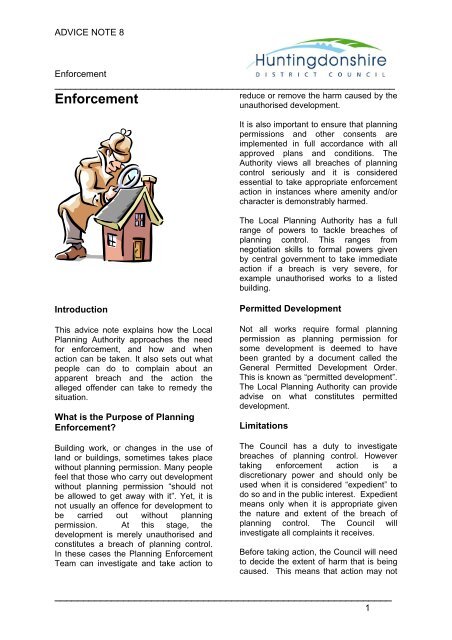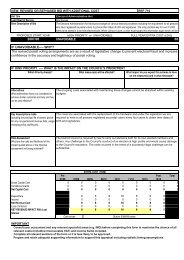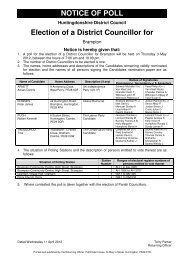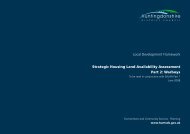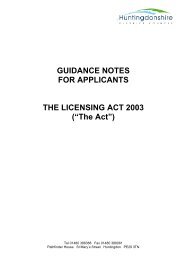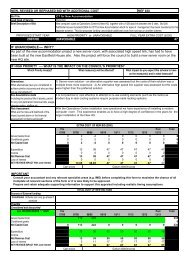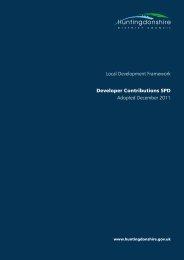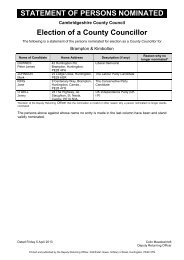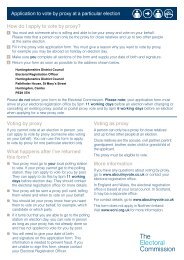Planning Enforcement - Huntingdonshire District Council
Planning Enforcement - Huntingdonshire District Council
Planning Enforcement - Huntingdonshire District Council
You also want an ePaper? Increase the reach of your titles
YUMPU automatically turns print PDFs into web optimized ePapers that Google loves.
ADVICE NOTE 8<strong>Enforcement</strong>_________________________________________________________________reduce or remove the harm caused by the<strong>Enforcement</strong>unauthorised development.It is also important to ensure that planningpermissions and other consents areimplemented in full accordance with allapproved plans and conditions. TheAuthority views all breaches of planningcontrol seriously and it is consideredessential to take appropriate enforcementaction in instances where amenity and/orcharacter is demonstrably harmed.The Local <strong>Planning</strong> Authority has a fullrange of powers to tackle breaches ofplanning control. This ranges fromnegotiation skills to formal powers givenby central government to take immediateaction if a breach is very severe, forexample unauthorised works to a listedbuilding.IntroductionThis advice note explains how the Local<strong>Planning</strong> Authority approaches the needfor enforcement, and how and whenaction can be taken. It also sets out whatpeople can do to complain about anapparent breach and the action thealleged offender can take to remedy thesituation.What is the Purpose of <strong>Planning</strong><strong>Enforcement</strong>?Building work, or changes in the use ofland or buildings, sometimes takes placewithout planning permission. Many peoplefeel that those who carry out developmentwithout planning permission “should notbe allowed to get away with it”. Yet, it isnot usually an offence for development tobe carried out without planningpermission. At this stage, thedevelopment is merely unauthorised andconstitutes a breach of planning control.In these cases the <strong>Planning</strong> <strong>Enforcement</strong>Team can investigate and take action toPermitted DevelopmentNot all works require formal planningpermission as planning permission forsome development is deemed to havebeen granted by a document called theGeneral Permitted Development Order.This is known as “permitted development”.The Local <strong>Planning</strong> Authority can provideadvise on what constitutes permitteddevelopment.LimitationsThe <strong>Council</strong> has a duty to investigatebreaches of planning control. Howevertaking enforcement action is adiscretionary power and should only beused when it is considered “expedient” todo so and in the public interest. Expedientmeans only when it is appropriate giventhe nature and extent of the breach ofplanning control. The <strong>Council</strong> willinvestigate all complaints it receives.Before taking action, the <strong>Council</strong> will needto decide the extent of harm that is beingcaused. This means that action may not___________________________________________________________1
ADVICE NOTE 8<strong>Enforcement</strong>_________________________________________________________________always be taken. Where it is taken, thiscan be quick and effective when it isclearly necessary.<strong>Enforcement</strong> action must be taken inaccordance with legislation andgovernment guidance, the <strong>Council</strong>'sadopted policies and any other materialplanning considerations. In someinstances a planning application may beinvited so that otherwise acceptabledevelopment may be formally approved.Where permission is likely to be refused,the <strong>Council</strong> will negotiate to stop orremedy the harmful effects of thedevelopment. Formal action will be takenwhere this cannot be achieved.There is always a need to considerHuman Rights issues, particularly whereresidential accommodation is concerned.This is an important considerationhowever harmful the breach of planningcontrol may be.Guidance on enforcement can be found inPPG18 – Enforcing <strong>Planning</strong> Controlwhich can be viewed atwww.communities.gov.ukTime LimitsWhere a breach of planning control isconfirmed, it may nonetheless be immunefrom enforcement action. Action must betaken within the statutory time limits.These limits are essentially:• four years from the substantialcompletion of operationaldevelopment (building works etc.)• four years from the change of useof any building to use as a singledwellinghouse;• ten years for all other changes ofuse; and• ten years for breach of a conditionattached to a planning permission.There is no limitation period for takingenforcement action in respect of listedbuildings. This means that a new ownercan be liable to enforcement action inrespect of a breach by a former owner.In those cases where enforcement actionis not taken, the development will becomelawful at the end of the statutory time limit.How to Make a ComplaintIn large part, the <strong>Council</strong> relies on thepublic to help identify breaches ofplanning control. The involvement ofindividuals, <strong>District</strong> <strong>Council</strong>lors andTown/Parish <strong>Council</strong>s is welcomed at allstages of the enforcement process. It ishelpful if, other than in cases ofemergency, concerns are expressed inwriting/e-mail. A complainant’s identitycan remain confidential while and after thecomplaint is being investigated.The <strong>Council</strong>’s planning enforcement teaminvestigates all validated breaches ofplanning control, however somecomplaints are outside their remit. Forexample the team does not deal with highhedges, boundary disputes, landownership issues, noise and/or odourcomplaints (unless it constitutes a changeof use or a breach of a condition of aplanning permission), neighbour disputesor malicious/racist complaints. Mineralsand waste matters and highway issues arenormally dealt with by CambridgeshireCounty <strong>Council</strong> (seewww.cambridgeshire.gov.uk) anddrainage problems are often referred tothe Environment Agency or InternalDrainage Board.Complaints can be made by e-mail (viathe ‘<strong>Planning</strong> <strong>Enforcement</strong> ComplaintForm’ on the <strong>Council</strong>’s websitewww.huntsdc.gov.uk), telephone, inperson to the Customer Service Centre, orby letter addressed to <strong>Planning</strong> Services,<strong>Huntingdonshire</strong> <strong>District</strong> <strong>Council</strong>,Pathfinder House, St Mary’s Street,___________________________________________________________2
ADVICE NOTE 8<strong>Enforcement</strong>_________________________________________________________________Huntingdon PE29 3TN. Complainants are the complaint and thereafter on a monthlyasked to give us as much information as basis as required. Outcomes may seem tothey can (e.g. the exact site address, what take a while to be achieved due to thethey think is the breach and why, when negotiations involved and the need toactivities started, names, addresses and allow the person reasonable time totelephone numbers of owners and address the matter.occupiers or other persons responsible).For a change of use, we may ask the More information regarding howcomplainant to compile a diary of events complaints are handled can be found ineg. comings and goings, vehicle the <strong>Council</strong>’s <strong>Planning</strong> <strong>Enforcement</strong> Policyregistration numbers, opening hours, etc available on the <strong>Council</strong>’s website.to support the <strong>Council</strong>’s owninvestigations.What Happens when a Complaint isMadeFollowing initial checks of records held,complaints received by the <strong>Planning</strong><strong>Enforcement</strong> team are entered onto thecomputer system and raised as a file forinvestigation. An acknowledgement letteris issued giving the Case Officer’s contactdetails. An initial site visit is usuallyconducted within 10 working days of thefile being raised, and within 24 hours ifimmediate action may be necessary, atwhich the Officer will try to identify whetheror not there is a breach of planning controland assess any harm resulting from thedevelopment. Harm comprises a numberof elements. In order to assess the level ofharm a scoring system is used todetermine a harm rating. Each complaintis scored using this system and the ratingdefines the appropriate action to be taken.In cases where there is little or no harmthe only action may be to advise therelevant person of the need for planningpermission and invite an application toregularise the breach of planning control.In instances were serious harm isidentified, the person may be required todemolish a structure or cease an activity,and ultimately formal action may be takenby way of a Notice, prosecution orinjunction – see details of types of formalplanning enforcement action below.A more detailed response is sent to thecomplainant within 28 days of receipt ofWhat the Alleged Offender ShouldDoIf a person is contacted by a member ofthe <strong>Planning</strong> <strong>Enforcement</strong> Team, he/sheshould provide as much information aspossible to enable the Officer to decidewhether or not there is a breach ofplanning control. A meeting on site is oftenthe best way to do this, although it may bepossible by a phone call or letter.Prompt responses to correspondence willhelp to speed up the process, and he/sheshould make every effort to meetdeadlines for remedial action. The CaseOfficer will check to ensure that actionshave been completed satisfactorily. If forany reason a deadline cannot be met, theperson should contact the Case Officer toagree what will be done.Types of Formal <strong>Planning</strong><strong>Enforcement</strong> ActionGovernment Guidance makes clear thatformal action should usually be a lastresort when attempts to resolve the matteramicably have failed. Put simply,enforcement action will only be consideredwhether the development is unauthorised,unacceptable, is not immune fromenforcement and attempts to resolve itamicably have failed.Where formal action is appropriate, thereare several options available, the mostcommon being those outlined below:___________________________________________________________3
ADVICE NOTE 8<strong>Enforcement</strong>_________________________________________________________________If no appeal is submitted, the enforcementnotice comes into effect on the due date. Ifan appeal is submitted, this suspends theterms of the Notice. Thus, unless a stopnotice is issued, the unwelcome effects ofa development may lawfully continue untilafter an appeal has been considered. Ifthe appeal is successful, the mattersreferred to in the notice become lawful andno further action can be taken.ο <strong>Enforcement</strong> NoticeThis is the usual means by whichunauthorised development can beremoved or stopped. As previouslystated, it is not usually an offence fordevelopment to be carried out withoutplanning permission, but it is an offencenot to comply with an <strong>Enforcement</strong> Notice.An <strong>Enforcement</strong> Notice must specify whatthe alleged breach is, the reasons forissuing the notice, what action is requiredand the time given to do this. <strong>Enforcement</strong>notices are served on all interested partiesand have a right of appeal (furtherinformation regarding appeals can befound at www.planninginspectorate.co.uk).An appeal can be made on some or all ofthe following grounds. These are:• that planning permission should begranted for the allegeddevelopment;• the breach of control has notoccurred as a matter of fact;• there has not been a breach ofplanning control;• it was too late to take enforcementaction;• the notice was not properly servedon everyone with an interest in theland;• the steps required by theenforcement notice go beyondwhat is necessary to overcome theobjections; and/or• the time given to comply with thenotice is too short.There are similar grounds of appeal forListed Building <strong>Enforcement</strong> Notices,although the appellant can also questionthe architectural or historic merit of thebuilding or argue that the works wereurgently necessary in the interests ofsafety or health or for the preservation ofthe building. Appeals are dealt with by the<strong>Planning</strong> Inspectorate in a similar way tothose for planning appeals.If the appeal is unsuccessful, the periodfor compliance starts from the date of theinspector’s decision letter. In some cases,this could amount to anything up to afurther 12 months. If an <strong>Enforcement</strong>Notice is not complied with prosecutionproceedings can be brought and/orOfficers have authority to enter land, carryout remedial work, and reclaim the costsfrom the landowner.ο Stop NoticeThis requires that an unauthorised use orbuilding work should stop immediately. Itis therefore served at the same time as an<strong>Enforcement</strong> Notice. It is used to ensureserious breaches of planning control arenot allowed to continue.A Temporary Stop Notice can be servedwithout the need for an <strong>Enforcement</strong>Notice, but is only effective for 28 days.After this time the use or works maycontinue, unless other measures areundertaken.ο Breach of Condition NoticeThis is served where breaches of planningconditions are identified. There is no rightof appeal against such a Notice and noncomplianceconstitutes a criminal offence.ο Untidy Land (Amenity) NoticeIf land or a building is so untidy that itaffects local amenity, steps can be takenthat require it to be cleared up. Itscondition, however, must not be the resultof lawful operations or use of the land.Thus, an owner is not expected to keep a___________________________________________________________4
ADVICE NOTE 8<strong>Enforcement</strong>_________________________________________________________________site tidy while authorised building worksare being carried out for example.ο Tree Replacement NoticeThis requires a landowner to replant a treeor trees that were subject to a TreePreservation Order and removed withoutpermission. The <strong>Council</strong> can specify thesize and species of the replacementplanting.ο InjunctionInjunctions are granted in the CountyCourt or High Court and can be used tocontrol the use of land but only in extremecases where the effects are particularlyharmful. An injunction can be sought foran actual or likely breach of planningcontrol. Contravention of an injunction is acriminal offence for which the Court mayimpose a fine or a custodial sentence.August 2009Please Note: This advice note is intended as ageneral guide. It should not be relied upon, or takento be a full interpretation of the law.___________________________________________________________5


